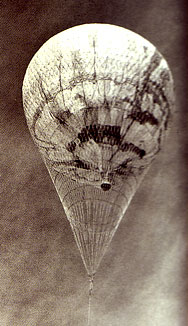


USA Eagle Patriot Balloon - $$6.95
The Screaming Eagle balloon from Fiddlersgreen.net, a great patriotic addition to your collection to which you can add your own special phrases, mottos, and quotes. Easy to build in just an evening and perfect to hang from the ceiling in the kid's room or office. Included in the Balloons and Airships Collection CD.
Screaming Eagle Card Model Balloon
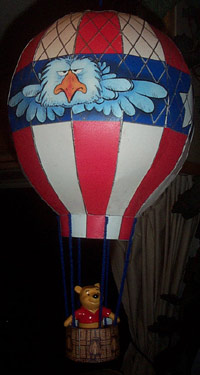
This interesting balloon just happened to come together as we were putting the historical Balloon Collection together. The eagle AND the banners that are included on page one, are quite American. the eagle comes with extra wings that can be added for a three dimensional effect.
Like all the other balloons, you can choose to print only the panels that have stripes and stars and loose the funky eagle, Enjoy this page, you'll find lots of information about balloons and their use during wartime.
Eagle looks like he hasn't had his coffee yet. For "friendly"I always liked Sam the Olympic Eagle Mascot. (Aside from that,an eagle's job is to look like they are inclined to kill something- soon.) C.
Hi Chip, What about the Virgin Flyer?!! Could you make a model of it? Richard Branson would agree I am sure (your models are good for schools)! I bet you have loads of e-mail ref this!! Pity about my stroke, but working on it, it is like only having one good hand to do everything! Try it! Still better than watching daytime TV!! Kind regards Gary ...
Barrage Balloons in World War 2
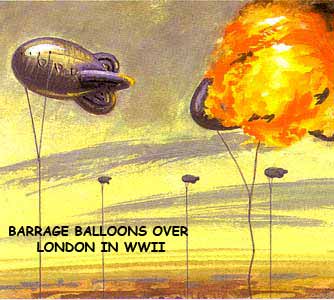 In the early nineteen-thirties captive and barrage balloons were
completely eliminated as military equipment in favor of observation
aircraft with their greater mobility and reduced vulnerability.
However, when World War II broke out the balloon once more regained
its importance, though only in the part of barrage balloon. The
object of such barrages is to protect particularly vulnerable
targets against attacks by dive-bombers and low-flying aircraft.
In the early nineteen-thirties captive and barrage balloons were
completely eliminated as military equipment in favor of observation
aircraft with their greater mobility and reduced vulnerability.
However, when World War II broke out the balloon once more regained
its importance, though only in the part of barrage balloon. The
object of such barrages is to protect particularly vulnerable
targets against attacks by dive-bombers and low-flying aircraft.
Two forms of such barrages were prepared: stationary and mobile ones. The first style was planned for use at altitudes of tip to 10,000 ft and here relatively large, well-anchored balloons were used. The mobile balloons were moored to motor vehicles, ships or ligi-iters and were seldom raised to altitudes of more than 1,970 ft. There was no denying that the balloons were vulnerable, but gathered estuary and other waterways of similar importance had to be denied to enemy minelayers as much as possible.
During the German attacks on the southernmost flying fields in England and on the Allied convoys, Balloon Command played an important part. During the 'Battle of Britain' about 2,400 balloons were in the air. The personnel handling them often worked under difficult conditions as many of the small stations were located in secluded spots which hampered the flow of stores and other supplies and made the service life very monotonous.
In 1942 many of the male personnel of Balloon Command were replaced by women of the W.A.A.F. (Women's Auxiliary Air Force). When the German High Command at about the same time launched the 'Baedecker raids' against English historical cities these servicewomen were subjected to great strain, and volumes could be written about their sacrifices and about the courage they displayed. To mention one single incident, Corporal Lillian Ellis in May 1943 was awarded the British Empire Medal for courage displayed in remaining at her station in South Wales during an air attack, though she was wounded.
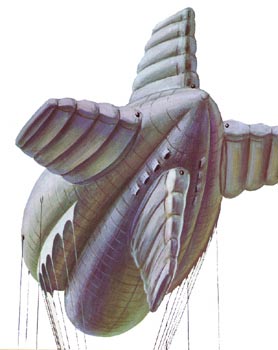 Even
Balloons (unmanned) had a role to Even
Balloons (unmanned) had a role to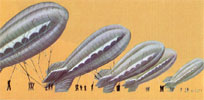 play in WWII. Though observation balloons had proved too vulnerable
to enemy fire, massing large numbers together became a balloon
barrage. The mooring cables of this array of balloons proved a
deadly barrier to low-flying aircraft. In darkness enemy aircraft
might be brought down by flying into these cables, and in daylight
they could be forced to fly at higher altitudes where their bombing
accuracy would suffer, and they would be more vulnerable to anti-aircraft
fire.
play in WWII. Though observation balloons had proved too vulnerable
to enemy fire, massing large numbers together became a balloon
barrage. The mooring cables of this array of balloons proved a
deadly barrier to low-flying aircraft. In darkness enemy aircraft
might be brought down by flying into these cables, and in daylight
they could be forced to fly at higher altitudes where their bombing
accuracy would suffer, and they would be more vulnerable to anti-aircraft
fire. |
The largest balloon barrage on record comprised 1,750 units and was formed in 1943 to assist the Home Defense during the threat of the V1 flying bombs. Eight thousand of these weapons were dispatched, at a daily average of 100 for 80 days. Of these 29 per cent got through to the London area. Of the remaining 71 per cent a total of 279 doodlebugs were stopped by the balloon barrage.
Most of the Allied operations with the object of establishing
bridgeheads on the coastlines occupied by the enemy were supported
by units from
Balloon Command. They were in action on Sicily and in Italy, landed
with the attacking troops on Corsica and at Salerno, and likewise
participated in the Persian Gulf and at Suez. Balloon Command
also toiled during the preparations for the invasion of northern
France in 1944 and afterwards had 4,000 men engaged when these
bridgeheads on the Channel Coast were established.
Balloon Command was disbanded on 5 February 1945, as by then there was no longer much likelihood of renewed air attack on England, since the German Luftwaffe had lost the initiative. Yet balloon barrages reappeared in the final stages of the war, Montgomery's forces using them in Holland, on the Rhine and elsewhere.
One of the standard British types of captive balloon, the so-called 'L.Z.' which was based on the French Caquot model from 1915 was sent to the United States during the war. In that country it became the inspiration for the ZK balloon mass-produced by Goodyear. Though the United States was not threatened by direct air attack at any time during the war, six balloon squadrons were formed to protect naval bases and depots. The American balloon barrages were operated almost exclusively by the U.S. Army and U.S. Marine Corps.
Fu-Go Japanese Balloons
On 18 April 1942 Lt Col James H. Doolittle led 16 North American
B-25 Mitchell bombers in a surprise raid on Tokyo. They caused
little damage to the city, but the effect on morale was far-reaching,
as an American attack on the Japanese capital had hitherto not
been considered feasible such a short time after Pearl Harbor.
This air attack even influenced Japan's strategy in the Pacific,
but at the same time her military leaders fervently desired to
retaliate against the American mainland. The solution plan sounded
like simplicity itself. When the winds were favorable the United
States was to be saturated with balloons carrying 5 or 12 kg incendiary
bombs and 15 kg antipersonnel bombs to wreak havoc on American
cities, forests and crops, and to kill many people.
A couple of years were spent in manufacturing the balloons with their bombs and, above all, the necessary automatic release equipment. Finally, on 3 November 1944, the first of (eventually) some 9,3oo balloons of this kind were launched. Two days later 4 November, having crossed the international date line), one of these was found floating, without its load of bombs, in the Pacific Ocean near San Pedro, off the coast of California.
This Japanese concept of balloon bombs really dated from 1933, when the Japanese also tried to develop other revolutionary weapons. One of these experiments resulted in a tiny radio controlled, unmanned armored vehicle given the code name 'I-Go'. Another of these weapons was a rocket identified as 'Ro-Go'. This arsenal was even to include an electrical 'death-ray', but the balloon bomb 'Fu-Go' was considered the most promising. The main problem in connection with this scheme was to evolve a way of maintaining a steady altitude for the period of fifty to seventy hours required for the crossing of the Pacific, a distance Of 5,965 miles, and a means of releasing the bomb load in the United States at the proper time. Japanese ingenuity solved both problems, at least on paper.
The gas escape valve was to be combined with an automatic ballast release mechanism. This consisted of a cast aluminum wheel, mounted horizontally on to which were hooked 32 sandbags. The ballast bags hung in pairs, and each pair was fitted with a release fuse that could be fired by means of an aneroid connected to a small battery. Whenever the balloon sank to a pre-set minimum altitude, either due to loss of gas or because it was cooled down, a fuse was ignited and two of the sandbags were dropped. When the load of sandbags was spent the bomb load in its turn was released and the balloon would destroy itself by means of a small explosive charge. Ahead of the balloons carrying bombs, other balloons were released which carried radio equipment to send back information about the weather and wind conditions along the route. The Japanese scientists realized that these bomb carrying balloons must be dispatched during the winter months, because the easterly winds predominate from October to March.
The envelopes of these balloons were made of three or four
layers of silk tissue paper glued together. The envelopes had
a diameter of 32.8 ft and contained 19,070 cu-ft of gas. When
fully inflated with hydrogen they had a lifting capacity of 992
lb at ground level and of about 298 lb at an altitude Of 29,530
ft. The envelopes were contained in fabric 'parachutes' which
covered their top half and from which the bomb load and ballast
mechanism were suspended in the usual balloon style, except that
the hoop or ring and car suspension of the larger balloons were
replaced by two knots. While the Japanese experimented with the
'FuGo' weapon they also trained crews to handle these balloons
and selected the bases from which to release them. Three bases
were established, all located on the east coast of Honshu Island.
When the preparations had been completed a mass production of
the balloon envelopes was initiated at several places around Tokyo.
Schoolchildren mainly were employed to glue the sheets of tissue
paper together. Later the envelopes were also made of silk.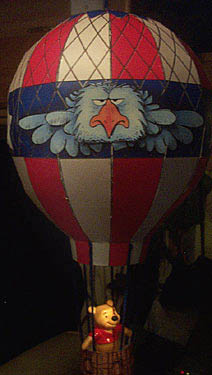
The Japanese Major General Sueyoshi Kusaba was in complete charge
of the 'Fu-Go' project and personally watched the first dispatches
closely. He had more than 10,000 of these balloons, available
and a time limit of five months in which the winds would be sufficiently
favorable to prove the feasibility of this scheme, so it was a
race against time. The Japanese intelligence service was alerted
to run down any reference to the balloons that might be printed
or broadcast in the United States and reveal or hint what effect
they had had there.
The 'Fu-Go' balloons did actually reach the United States and for a while puzzled everybody there. The finding of the first 'dud' has already been mentioned. On 6 December 1944, a bomb crater was discovered near Thermopolis in Wyoming. The third balloon to reach the U.S. mainland was found on 11 December in the neighborhood of Kalispell in Montana. On 31 December a balloon and some of its equipment were found at Estacada in Oregon; and several more balloons were found early in January 1945. The experts of the defense forces soon established the origin and purpose of the balloons. Discreet investigations were conducted. It was mainly the hazard of the incendiary bombs to the dry forests that was feared, the safety of the public did not seem at stake, so the American press agreed voluntarily to abstain from any reference to the finding of these balloons. However, the discovery of the first two balloons had already been mentioned in newspapers and broadcasts, and the Japanese possessed this news.
On 5 May 1945 a woman and five children were killed in the vicinity of Lakeview in Oregon when one of the balloon bombs exploded while they were pulling it out from under some trees. It was then decided to advise the public fully about the balloon bombs, even if this would aid the Japanese. What the Americans did not know at that time was that the Japanese had already abandoned the project, about a month before the Lakeview incident.
More than nine thousand bombs had been dispatched, while another 1,000 had been defective; of the former, only 285 were accounted for, most of which were found all over the U.S.A., Canada, Alaska and Mexico. In March 1945 General Kusaba was suddenly ordered to halt his activities. The Japanese general staff now considered this scheme stupid and pointless, since they had had no evidence of its effects.
This does not end the story of the 'Fu-Go' weapon, which in a way can justly be termed the first intercontinental missile on record. On 1January the American Defense Department circulated a bulletin about the recent find of a fully-live balloon bomb in Alaska, and at the same time issued the warning that several hundred more of these dangerous weapons might still turn up in different states. It would be a tragedy if American lives were still to be lost from weapons used in a war which ended more than a quarter of a century ago.
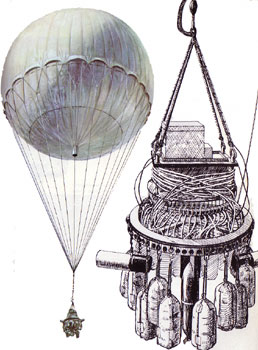 A close up view of the Fu-Go business end showing the fire bombs, percussion shells and ballast bags |



